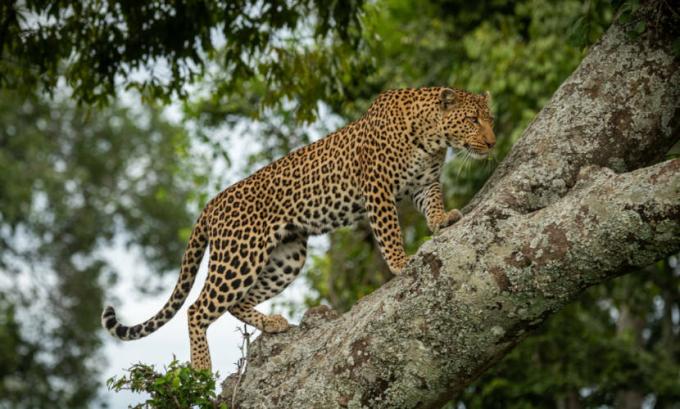leopards they are mammals felines found in regions of Africa and Asia. belong to the gender panthera, the same as other big cats, such as the lion and the jaguar. They are great hunters and can climb trees, which helps them to prevent their meal from being stolen by others. animals.
Read more: Lion - considered the second largest feline in the world, lives in the african savannas
What is the classification of leopards?
Leopards are animals belonging to the class of mammals, to the order carnivora, the family Felidae, to the genre panthera and to the species Panthera pardus. Nine leopard species are currently recognized, according to the International Union for Conservation of Nature (IUCN).
leopards | |
Subspecies |
where are found |
panthera pardus pardus |
Africa |
panthera pardus nimr |
arabia |
Panthera pardus saxicolor |
Southwest Asia |
panthera pardus melas |
Java |
panthera pardus kotiya |
Sri Lanka |
Panthera pardus fusca |
Indian Subcontinent |
Panthera pardus delacouri |
Southeast Asia, South China |
Panthera pardus japonensis |
North China |
panthera pardus orientalis |
Russian Far East, Korean Peninsula, and Northeast China |
What are the general characteristics of leopards?
The leopard is a feline that presents striking coat, which varies from light yellow to reddish orange and it is full of black spots. These spots resemble a rose and are called, for this reason, rosettes. Leopard spots do not have black dots in the center, as occurs in jaguars, in addition, they are smaller and closer together. In puppies a gray coat is observed, it is not possible to differentiate the rosettes.

Some leopards have black fur, being known as black Panthers. This situation is known as melanism and it occurs due to the presence of a gene that stimulates an exaggerated production of pigment, a situation opposite to what we observe when we talk about albinism. According to some researchers, melanism is a condition that helps black panthers become camouflage in closed forests.
These cats can reach about two meters long and weigh up to 90 kg. They are considered the fourth largest feline in the world. The size of the animal varies according to the place where it lives, being observed a larger size in those who live in savannas and forests.
Generally speaking, males are larger than females. Leopards have a flexible body, small round ears, long whiskers, long neck, long tail and short legs. This animal's tail helps it maintain its balance. On the leopards' paws, the presence of strong claws, which are sharp and retractable.
They stand out as excellent hunters. This ability is achieved, among other factors, due to its agility, which can reach about 60 km/h and jump over six meters horizontally and three meters vertically. In addition to being agile animals, they have accurate vision and hearing.
Leopards are solitary animals with twilight/night habits. They inhabit large territories, which are marked with urine, feces, in addition to marking with their claws. Leopards are able to emit sounds, which also serves to mark its territory.
Read too: Rhinoceros - large memmals that still suffer a lot from poaching
Where are leopards found?
Leopards are found in regions of the Africa and Asia, where they occupy a wide variety of habitat. Among the places where they are found, we can mention the regions of savannas, woods, forests, mountains and deserts.
What do leopards eat?
leopards are animals carnivores, therefore, feedswow of other animals. Among the animals that serve as food for leopards, we can mention small and large mammals (such as antelopes), reptiles, birds and even insects.
The type of food consumed by them is related to the availability of prey and also to the presence of other animals that compete for food, such as lions and hyenas. When leopards notice the presence of these competitors, they usually hide their food under the vegetation or place its prey on top of trees, especially when the ground cover is sparse. It is worth noting that leopards acquire a large part of the water they need for their food.

How do leopards reproduce?
The leopard's breeding season lasts all year, but its peak occurs during the rainy season. These animals have several partners, and the female's gestation lasts on average 96 days. Females give birth to two offspring usually every 15-24 months.
Leopard cubs weigh about a pound at birth, and for the first week they keep their eyes closed. At first, females keep their offspring hidden in hiding places so that they are not predated by other larger animals such as lions. The puppies come out of hiding more regularly from the sixth or eighth week, at which time solid food intake is started.
Weaning occurs when puppies are three months old, but independence only takes place when they reach 20 months of age. In the wild, the leopards live from 10 to 12 years, however, in captivity, they can reach more than 20 years.
Read more: Animal reproduction - can be asexual or sexual
What are the threats to leopards?
Leopards are currently classified by the IUCN as vulnerable and populations of this species have decline. There are many factors that contribute to the reduction in the number of these animals, such as reduction in the number of prey, destruction of their habitat and even conflicts with human beings, since these animals can feed, for example, on cattle.
Leopards are also seen as trophies, being often captured by poachers. Many hunters fuel the illegal fur trade of these animals. In some regions, leopards are killed for use for medicinal and ceremonial purposes.


